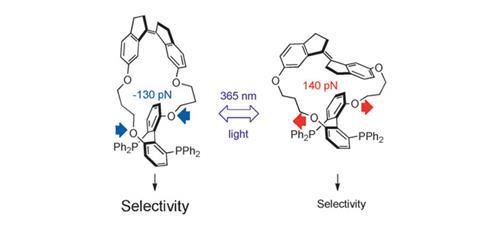Switchable ligand flips between strained and relaxed forms altering reaction enantioselectivity

Researchers have discovered that enantioselectivity in palladium-catalysed reactions depends on the ligand’s intramolecular strain.
Ligands are essential to provide the chiral environment for enantioselective catalysis. Chiral bidentate phosphine ligands, which clamp transition metals between their two phosphorus units like pincers, are particularly popular in palladium- or rhodium-catalysed reactions. When tuning ligand properties to increase enantioselectivity, researchers have traditionally focused on geometric or electronic characteristics.
Now, chemists from Duke University, Durham University and the University of Liverpool have shown that phosphine ligands’ internal strain strongly influences enantioselectivity. They designed a phosphine containing a cyclic, photoreactive unit that, when irradiated, switched the ligand from a compressed to a widened conformation. In a Heck reaction with a palladium catalyst, the compressed ligand was highly enantioselective, while the same reaction with the widened ligand produces only a small excess of one of the enantiomeric products.
The team is now hoping to create a new class of switchable ligands with tunable internal strain so that chemists can control the enantioselectivity of catalytic reactions.






No comments yet